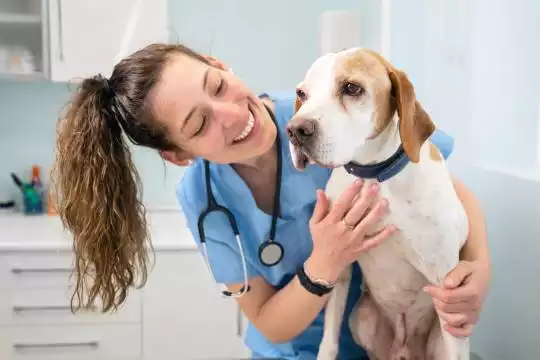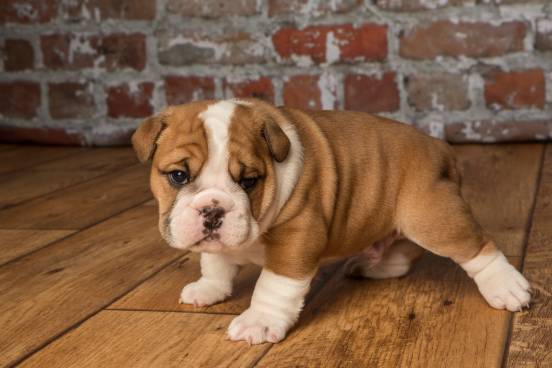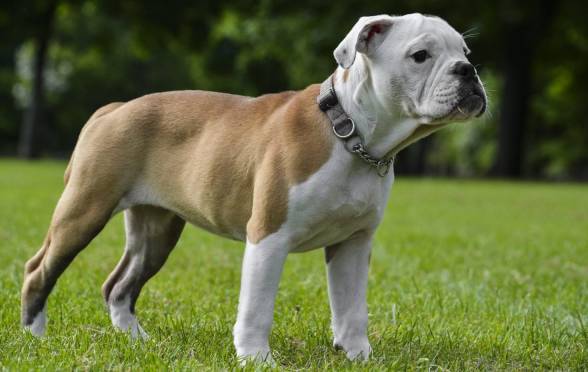You know a Bull dog when you see one! These dogs are low to the ground, with legs set wide apart making their body look a little squarish. Their faces have squished noses, a wrinkly forehead and jowls, and their lower jaw sits out a bit farther than their upper jaw. These beautiful dogs have become one of the most sought after in the US, but they suffer from many health issues, and more.
Connect with a verified veterinarian in minutes. Licensed vets are available 24/7 to answer your questions. No need to worry about your furry family member.
The problem is that Bulldogs, while loving companions, have been so inbred, and bred for specific characteristics that they’ve become unhealthy. In fact, over the past 100 years, the Bulldog has gone from a very healthy dog to one of the unhealthiest. Breeding has taken Bulldogs to such an extreme that they’re very welfare is sacrificed in order to make humans happy.
History of the Bulldog
The breed, once commonly called English Bulldog, first appears in records dating back to 1568. In that time, Bulldogs were working dogs used to herd cattle. From there, they eventually were used for bull baiting or bear baiting, which eventually became illegal in 1835, with the passing of the Cruelty to Animals Act.
People who loved the dogs wanted to save the breed, however, and so decided to breed out the aggression that made the Bulldog great bull and bear baiting. The dogs were eventually taken to Germany and the US. In Germany, the dogs were bred with other dogs to create the Boxer, while in the US Bulldogs were used again as working dogs in herding cattle.
Eventually, the dogs were sought as family and companion animals. Their popularity has quite literally exploded, so that now Bulldogs are the 5th most wanted dog on the AKC’s Breed Popularity list. This when it’s clear these poor dogs suffer from a plethora of health issues.
Compare the Modern Bulldog with their Ancestors from 100 Hundred Years Ago
Just 100 years ago, the Bulldog was a healthy breed. They were very athletic and used as working dogs. Since that time, breeders have tried to breed dog with characteristics wanted by their buyers. These included a flatter face, shorter legs, a huge head, with a large underbite.
Some of these changes to the face were made to make the Bulldog more expressive. Some have said their cute faces also remind people of children or babies.
For this reason, the dogs now look almost nothing like their Bulldog predecessors from just a hundred years ago. And through this process of breeding characteristics to please humans, the dogs suffer from increased health issue. Humans have almost completely forgotten about the welfare of the dogs, instead focusing on their own preferences.

Review symptoms, medications & behavior to keep your pets healthy with a Vet Online in just minutes.
Ask a Vet Live NowThe Many Health Issues of the Bulldog
Bulldogs suffer from a wide variety of horrendous health issues. Let’s take a look.
1). Caesarean births: because the dog’s head has been bred to be so large, only about 80 to 95% of mother dogs can birth their puppies naturally. The puppy’s heads are now too large to fit through the mother’s birth canal. This means the mothers must have Caesareans just to have their puppies. Every time a mother dog has puppies, she must go through this process.
2). Difficulty breathing: because of their extremely shortened snouts, Bulldogs are one of the breeds that suffer from Brachycephalic Airway Syndrome. This is a very serious medical problem that makes breathing not only uncomfortable but also difficult. It’s not only their shortened snouts that are the problem. Bulldogs also suffer with:
- Elongated soft palate: the soft palate in many dogs goes all the way back into their airways. This makes it hard to breath because the soft palate creates more resistance in the airway. You might equate this with something like Obstructive Sleep Apnea, which is caused by the tongue and too much tissue in the throat and airways, which make breathing difficult when sleeping.
- Stenotic nares: if your dog has pinched or narrowed nostrils, which are too narrow, breathing can be almost impossible (depending on how narrow the nostrils are). This is one of the reasons that Bulldogs tend to snore and snort.
- Pneumonia: this can be a bacterial or viral infection of the lungs. Bulldogs have a tendency to develop pneumonia more than other breeds.
3). Temperature regulation: because Bulldogs are Brachycephalic, they are not able to pant to help regulate their body temperature. When it gets hot, these dogs can’t keep themselves cooled off, and they can easily develop heat stroke. For this reason, pet parents are told to keep their dogs in an air-conditioned environment when it goes above 80F.
4). Skin problems: these beautiful, loving companion dogs also suffer from a variety of skin issues including:
- Eczema
- Bacterial skin infections
- Hot spots (also called acute moist dermatitis)
- Interdigital cysts (that form between the toes)
5). Bone and joint conditions: Bulldogs also suffer from several bone and joint conditions because of their bone structure. They are prone to developing:
- Canine hip dysplasia
- Joint and ligament injuries
- Arthritis
6). Other health conditions: Bulldogs also suffer from a variety of other health issues including:
- Eye problems
- Head shakes
- Allergies (skin and food)
- Thyroid & heart disease
- Cancer
7). Short life spans: the average life span of a Bulldog today is about 6-7 years, or less.
Pet parents who adopt a Bulldog often are heartbroken when their fur babies suffer from so many health problems. And sometimes, the pet parents aren’t able to afford the vet bills for the dog’s numerous problems, and the dogs end up in at shelters and rescues.
The Only Way to “Fix” the Bulldog Breed
These health problems have come about from breeding practices that have come from many unethical breeders. Their focus has been on customers, rather than on the dogs they breed and raise. And it’s not only Bulldogs facing these issues, but there are other breeds in the same sad shape due to poor breeding methods.
Breeders and others have wanted to try to save the Bulldog breed and improve the health of these dogs. However, researchers studied the DNA of 102 Bulldogs in the US. Their research results were not good—the breed was not genetically diverse enough to save. They said the only way the breed can be saved is through crossbreeding with other breeds.
These are all indications that Bulldog breeding has just gone too far, and there’s almost no way to move forward. To make these dogs healthy, it will be necessary to crossbreed them with other breeds. Otherwise, the breed will go extinct.
If you’re looking to get a Bulldog, avoid buying from breeders. Instead, try to adopt a Bulldog from a rescue. Do know they will be coming to you with many health issues. These dogs deserve loving families and fur ever homes, just like all dogs around the world.
Connect with a verified veterinarian in minutes. Licensed vets are available 24/7 to answer your questions. No need to worry about your furry family member.

Kyoko
Kyoko is from a family of 3 and moved to New York with her parents and siblings when she was 13. Kyoko is fond of spending a great amount of time with pets, specifically her beagle Luna and cat Missy. Her boyfriend often complains that she spends too much time giving attention to their animals. Kyoko has written dozens of articles concerning pets and is aiming at owning a pet shop one day!
Review symptoms, medications & behavior to keep your pets healthy with a Vet Online in just minutes.
Ask a Vet Live Now



